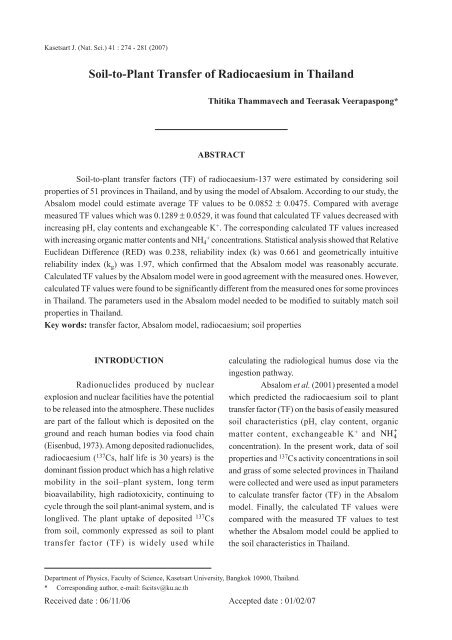April - June 2007 - Kasetsart University
April - June 2007 - Kasetsart University
April - June 2007 - Kasetsart University
You also want an ePaper? Increase the reach of your titles
YUMPU automatically turns print PDFs into web optimized ePapers that Google loves.
<strong>Kasetsart</strong> J. (Nat. Sci.) 41 : 274 - 281 (<strong>2007</strong>)<br />
Soil-to-Plant Transfer of Radiocaesium in Thailand<br />
Thitika Thammavech and Teerasak Veerapaspong*<br />
ABSTRACT<br />
Soil-to-plant transfer factors (TF) of radiocaesium-137 were estimated by considering soil<br />
properties of 51 provinces in Thailand, and by using the model of Absalom. According to our study, the<br />
Absalom model could estimate average TF values to be 0.0852 ± 0.0475. Compared with average<br />
measured TF values which was 0.1289 ± 0.0529, it was found that calculated TF values decreased with<br />
increasing pH, clay contents and exchangeable K + . The corresponding calculated TF values increased<br />
with increasing organic matter contents and NH 4 + concentrations. Statistical analysis showed that Relative<br />
Euclidean Difference (RED) was 0.238, reliability index (k) was 0.661 and geometrically intuitive<br />
reliability index (k g) was 1.97, which confirmed that the Absalom model was reasonably accurate.<br />
Calculated TF values by the Absalom model were in good agreement with the measured ones. However,<br />
calculated TF values were found to be significantly different from the measured ones for some provinces<br />
in Thailand. The parameters used in the Absalom model needed to be modified to suitably match soil<br />
properties in Thailand.<br />
Key words: transfer factor, Absalom model, radiocaesium; soil properties<br />
INTRODUCTION<br />
Radionuclides produced by nuclear<br />
explosion and nuclear facilities have the potential<br />
to be released into the atmosphere. These nuclides<br />
are part of the fallout which is deposited on the<br />
ground and reach human bodies via food chain<br />
(Eisenbud, 1973). Among deposited radionuclides,<br />
radiocaesium ( 137 Cs, half life is 30 years) is the<br />
dominant fission product which has a high relative<br />
mobility in the soil–plant system, long term<br />
bioavailability, high radiotoxicity, continuing to<br />
cycle through the soil plant-animal system, and is<br />
longlived. The plant uptake of deposited 137 Cs<br />
from soil, commonly expressed as soil to plant<br />
transfer factor (TF) is widely used while<br />
Department of Physics, Faculty of Science, <strong>Kasetsart</strong> <strong>University</strong>, Bangkok 10900, Thailand.<br />
* Corresponding author, e-mail: fscitsv@ku.ac.th<br />
calculating the radiological humus dose via the<br />
ingestion pathway.<br />
Absalom et al. (2001) presented a model<br />
which predicted the radiocaesium soil to plant<br />
transfer factor (TF) on the basis of easily measured<br />
soil characteristics (pH, clay content, organic<br />
matter content, exchangeable K + +<br />
and NH4 concentration). In the present work, data of soil<br />
properties and 137Cs activity concentrations in soil<br />
and grass of some selected provinces in Thailand<br />
were collected and were used as input parameters<br />
to calculate transfer factor (TF) in the Absalom<br />
model. Finally, the calculated TF values were<br />
compared with the measured TF values to test<br />
whether the Absalom model could be applied to<br />
the soil characteristics in Thailand.<br />
Received date : 06/11/06 Accepted date : 01/02/07
















